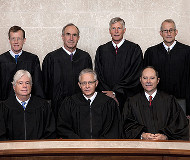5/1/2018
Iowa Supreme Court Ruling Means Gridlock Saves Speed CamsPro-speed camera ruling by Iowa Supreme Court effectively guarantees no limit on municipal use of the devices on freeways.

Limiting the number of speed camera citations mailed out from Iowa's freeways became much harder on Friday. The state Supreme Court torpedoed former Governor Terry Branstad's (R) effort to use the Iowa Department of Transportation to eliminate what the agency determined were the most unfair speed trap locations.
Unlike the high court's previous split decision granting cities the freedom to install speed cameras without legislative authorization (view 2008 ruling), Friday's ruling was unanimous in finding the state government cannot regulate speed cameras without first obtaining the General Assembly's permission.
That is likely to prove difficult, as the legislature is unable to come to a consensus on what to do with cameras. State Senator Brad Zaun (R-Urbandale) was able to pass a speed camera ban 32 to 18 in the upper chamber in February, but the photo ticketing industry knows it can count on the House to prevent the bill from ever becoming law.
Municipal lobbyists hired with public funds join with the photo ticketing industry's representatives in twisting the arms of state lawmakers. Sensys Gatso, the Swedish speed camera company, hired lobbyists Tom Fey and Mike St Clair. Redflex Traffic Systems of Australia retained Michael Rozenboom and Scott Weiser. American Traffic Solutions hired David Adelman, Sara Allen, Frank Chiodo and Matt Hinch to promote the industry's agenda.
In 2013, the Iowa Department of Transportation (IDOT) created a rule that said speed cameras should only be used as a last resort, and that a camera cannot be placed within a thousand feet of a speed limit change. The devices could only be placed in areas with a documented crash risk, and they had to demonstrate their effectiveness at reducing risk.
Outraged municipalities turned to the high court for relief, and they got it. The justices were not impressed by the state's argument that photo radar devices mounted on overhead freeway signs constituted an "obstruction" that the department has authority to clear.
"If the IDOT's interpretation were correct, the cities would be creating a public nuisance," Justice Edward M. Mansfield wrote. "Also, the prohibition only applies to obstructions 'within any highway right-of-way.' Notably, all the interstate automated traffic enforcement systems at issue in this case were mounted on existing overhead truss signs."
The high court was clear that there is nothing that inherently protects speed cameras from regulation, but that is the job of the General Assembly.
"If the legislature wants to expand the IDOT's powers to include regulation of automated traffic enforcement systems, it is, of course, free to do so," Justice Mansfield wrote.
The Iowa DOT issued a statement saying it would immediately comply with the ruling
"We respect and uphold the court's decision, which places regulation of automated traffic enforcement systems in the hands of the legislature," the agency stated. "However, municipalities that wish to establish automated traffic enforcement systems must still obtain a right-of-way permit to physically affix cameras and other automated traffic enforcement system hardware to state highway structures."
A copy of the ruling is available in a 200k PDF file at the source link below.


